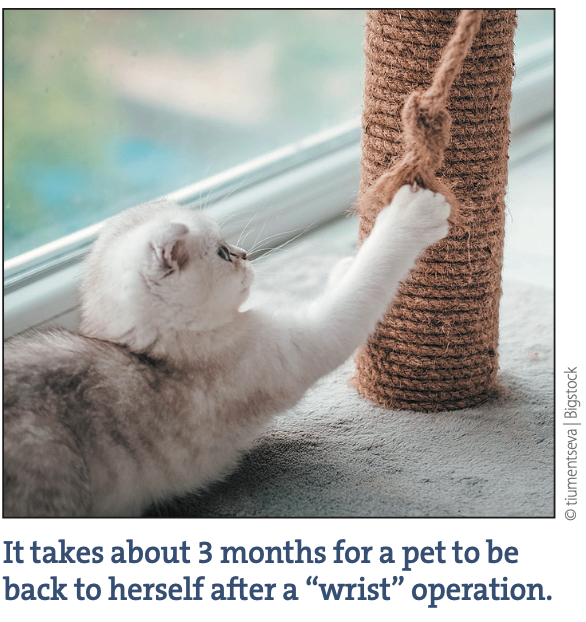Q: My cat was walking funny — kind of flatfootedly— and the vet took some x-rays and said she has something called carpal hyperextension and needs an operation. But couldn’t she just heal with a brace? I saw braces advertised for this condition online.
Helen Schecter
Bronx, New York
Dear Ms. Schecter,
A: A brace will not cure carpal hyperextension despite what you may have read online. It will simply provide support, so it would need to be worn forever — not a very practical option for a cat, who will likely balk at the notion of a brace (or a bandage), even for a short time.
The condition is an injury to the joint of a cat’s carpus, or “wrist” — the spot where the top of a front paw connects to the rest of the leg. Specifically, the ligaments in the wrist become stretched or torn due to a trauma — most often landing wrong after jumping from a significant height such as the second or third story of a building or the roof of a garage.
If the ligaments are only very mildly stretched or strained and there is not actual hyperextension, reducing activity and reducing pain with medication may be enough — although it can be touch-and-go because the legs continually bear weight as a cat walks, making it hard to heal.
If the ligaments are substantially stretched or torn, surgery to fuse the joint is usually necessary. The surgery does not repair the ligaments themselves, which would be difficult to impossible to do. Instead, it fuses the joint. The operation is called a carpal arthrodesis. The veterinary surgeon uses a plate and screws to immobilize the wrist while still allowing the leg to function. Mobility at the joint itself will never be normal, since the joint is fused, but overall limb use is very good, and it will allow your cat to enjoy a full life by providing stability and letting her go about her day without pain.
Talk to the doctor about the severity of the injury. Often, a surgery is the only way to get a cat comfortably back on her feet.
Note that it takes 6 to 8 weeks for a cat to heal fully, and during that time she will have to wear a splint to support the repair. The splint provides stability as the bones within the joint fuse together. Twelve weeks following the operation, a cat will usually be able to fully return to her normal level of activity.




